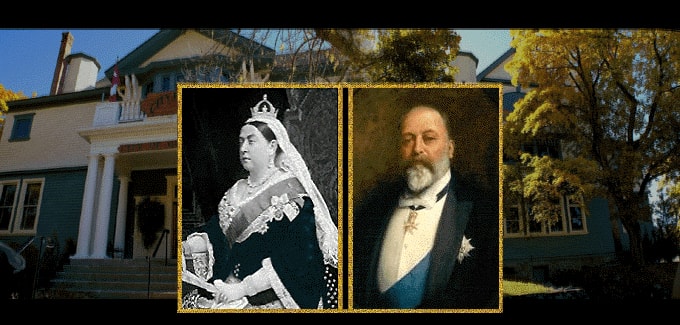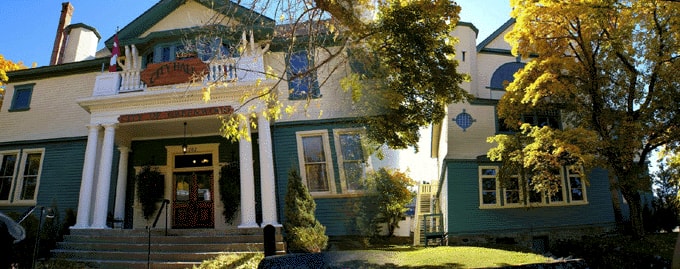Greenwood Architecture:
Victorian or Edwardian?
BY: BG EDITOR

Queen Victoria and King Edward VII
Jul 01, GREENWOOD, BC (BG)
Reading the many articles about Greenwood's historic architecture, we most often find the building
style referred to as Victorian. But occasionally there are references made to Edwardian architecture,
which begs the question: what's the difference between the two?
The answer begins with the timeline. Generally, an 'era' describes a period of time associated with
a particular person (e.g., a ruler) or a defining movement or event that dominates the timeline. But more important
than the timeline is the connotation of the spirit of the time in a given era. For example, styles of clothing can't
be pegged to a given period of years so much as to the mood of the time, because clothing expresses that mood. The same
is true with architecture.
Despite the fact that Greenwood's historic architecture is named after a famous personality
in Victorian England, these buildings emerged in the middle of a frontier mining town in Canada. Their architectural
style was clearly influenced by the mood of an English period design, but translated to this place, expressing the mood
of the day in turn of the century Greenwood.
Queen Victoria ruled the United Kingdom from 1837-1901, and this period generally marks the
Victorian Era. However, there are many social, cultural and academic examples of things we consider "Victorian"
that predate the Queen's reign.
The Edwardian Era is named after King Edward VII, who ruled from 1901-1910. But in terms of
the social mood of the day, the Edwardian period overlaps at both ends. At least the last six to eight years of
Queen Victoria's rule had a distinctly "Edwardian" mood, as did the early years of George V's reign, Edward's successor.
It's also interesting to note that the Great War (WWI) is generally classified as having occurred in the Edwardian Era.
If we look at the 58 standing heritage buildings in Greenwood that are described in Greenwood British
Columbia: Heritage comes alive by Al Donnelly, we see that only 39 of them were built in the Victorian Era, while 16
were built in the Edwardian Era. Among the Edwardian period structures is one of our most iconic: City Hall. But at
the end of the day, zeroing in on the architectural category that Greenwood's heritage buildings fall under seems to
have little to do with an English ruler's timeline, or with the prevalent social mood during the two periods.
The 'Greenwood style' simply relates to the architectural style itself. This is particularly so because Greenwood is
in British Columbia - not British England.
The 'spirit of the time' in Architecture
"Architectural styles appear and disappear due to fundamental shifts in society's values,
cultural priorities, moral attitudes and economic status, and are more than just a change in fashion. Most 'high'
style or academically-designed houses reflected a consciously-chosen image or mode of expression, which in British
Columbia was usually the revival of an historical European model." (Scott Barrett, Your Old House) [1]
The Edwardian Era is known as a progressive period of more 'relaxed' morals than the upright
Victorian society before it. Likewise, Edwardian houses sported more modern features, such as electricity and indoor
plumbing. But while Edwardian interiors were becoming more complex, their facades were going the opposite
direction - becoming more structurally simple than the elaborate Victorian 'gingerbread' styles.
The Edwardian mood is associated with two of Greenwood's famed architects:
Francis Mawson Rattenbury and George Dillon Curtis. Although neither produced architectural designs
for Greenwood that fell directly within the Edwardian style, both skirted Edwardian architecture in interesting ways.
In 1897, George Dillon Curtis opened an architectural practice in Nelson,
and began his work on what would be many commercial, religious, residential and public commissions
in the Kootenay/Boundary region. Among them were the Greenwood Courthouse and the Greenwood Public
School (1899). [2] Curtis is mentioned in the Biographical Dictionary of Architects in Canada [3]:
"He was also an admirer of the evolving Arts & Crafts movement in England,
and brought his own interpretation to the style with his design for the Provincial Courthouse at Greenwood, B.C. (1902)."

The Greenwood Courthouse (City Hall)
[ Photo: Best 100 Buildings in BC - Architecture Foundation of BC ]
The Arts and Crafts movement [4] originated in Britain during the turn of era
between the Victorian and Edwardian periods, between 1880 and 1910. It then became popular worldwide,
across Europe, North America and Japan. The style of Arts and Crafts focused on simple forms and folk motifs.
Like many art and architecture movements, it had its own underlying philosophy, advocating economic and social
reform and being essentially anti-industrial.
In the context of architecture, it's interesting to compare the emergence of the Arts and
Crafts style to the transition from Victorian to Edwardian style. Just as the Edwardian style was a reflection
of more relaxed morals and structural simplicity, the Arts and Crafts movement emphasized simple forms and common,
folksy motifs. Interestingly enough, the end of the Arts and Crafts movement, in 1910, coincides with the year the
Edwardian period itself ended.
In a future article we'll look at the design of the Greenwood City Hall as it compares to both
the Edwardian and Arts and Crafts style. Whatever the style, its grandeur is unmistakable, making it one of the most
photographed buildings in the region. In 2014, our City Hall was voted one of British Columbia's top 100 iconic buildings,
in a contest held by the Architecture Foundation of BC to celebrate 100 years of great architecture.
Another famous architect, Francis Mawson Rattenbury [5] built the Hotel Greenwood,
circa 1899 (no longer standing). He was known as one of the first architects to bring classic Edwardian-style
buildings to Canada. Some of the public buildings he designed, such as courthouses, banks and flagship hotels,
were done in the style called Beaux arts, also known as Edwardian neo-Baroque. Among these were his renovations
of the courthouse in Victoria, and his designs for the CPR's Hotel Vancouver (1902).
Prior to his work in Greenwood, however, Rattenbury had a challenging experience with his
work on the legislative building in Victoria. As the building progressed, the project budget nearly doubled, and
this put something of a damper on his enthusiasm for the elaborate Beaux arts style. By the time he arrived in
the Kootenay/Boundary and built Hotel Greenwood and other wood-framed hotels like the one in Rossland (1899), he
was more focused on function than form. Now, Rattenbury's design emphasis was on attractive frontages that had behind
them more practical, functional constructions and less of the grandiose style inspired by Beaux arts.
Although 36 of Greenwood's standing 58 heritage buildings were raised during the
Edwardian Era, few if any appear (at first glance) to meet the formal criteria for Edwardian style. City Hall's design
was influenced by an Edwardian architectural sub-movement, but leans more towards the Craftsman style. This is the
story of Greenwood's close brush with Edwardian architecture.
REFERENCES:
[1] Your Old House by Scott Barrett, National Trust for Canada






